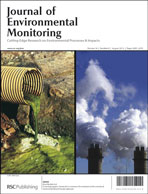Journal of Environmental Monitoring 14(8)
Overview of new articles on POPs in a new issue of Journal of Environmental Monitoring.

Knut Breivik, Jon A. Arnot, Trevor N. Brown, Michael S. McLachlan and Frank Wania
p. 2028-2037
- Quantitative knowledge of organic chemical release into the environment is essential to understand and predict human exposure as well as to develop rational control strategies for any substances of concern. While significant efforts have been invested to characterize and screen organic chemicals for hazardous properties, relatively less effort has been directed toward estimating emissions and hence also risks. Here, a rapid throughput method to estimate emissions of discrete organic chemicals in commerce has been developed, applied and evaluated to support screening studies aimed at ranking and identifying chemicals of potential concern.
Dieter Gladtke, Frits Bakker, Hugues Biaudet, Alexandra Brennfleck, Peter Coleman, Harald Creutznacher, Ben F. Van Egmond, Theo Hafkenscheid, Frank Hahne, Marc M. Houtzager, Eva Leoz-Garziandia, Edoardo Menichini, Anja Olschewski and Thomas Remesch
p. 2054-2062
- Different collector types, sample workup procedures and analysis methods to measure the deposition of polycyclic aromatic hydrocarbons (PAH) were tested and compared. Whilst sample workup and analysis methods did not influence the results of PAH deposition measurements, using different collector types changed the measured deposition rates of PAH significantly.
Andrew S. Brown and Richard J. C. Brown
p. 2072-2082
- The extent of correlation in polycyclic aromatic hydrocarbon (PAH) concentration data obtained by the UK PAH Monitoring and Analysis Air Quality Network from March 2008 to November 2010 has been assessed. Application of principal component analysis (PCA) to the dataset has revealed that the concentrations of the vast majority of PAHs are very highly correlated.
Persistent organic pollutants in sediment from the southern Baltic: risk assessment
Joanna Szlinder-Richert, Zygmunt Usydus and Aleksander Drgas
p. 2100-2107
- The concentrations of organochlorine pesticides, PCBs, and PCDD/Fs were measured in sediment samples collected from the Gulf of Gdańsk, the Gdańsk Deep, the Vistula Lagoon and the off-shore waters in the southern Baltic Sea. The determinations were conducted in the fraction <63 μm.
D. Bussolaro, F. Filipak Neto, A. Glinski, H. Roche, I. C. Guiloski, M. Mela, H. C. Silva de Assis and C. A. Oliveira Ribeiro
p. 2154-2163
- Few studies have investigated the bioaccumulation of persistent organic pollutants (POPs) in Brazilian native freshwater fish. In order to evaluate the bioavailability, potential risk to human exposure and the effects of POPs in the fish Hypostomus commersoni, muscle and liver samples of thirteen specimens were collected in a lake located in the city of Ponta Grossa (Parana State, Southern Brazil). Also, the liver and gills were considered for histopathological studies, and oxidative stress was investigated in the liver.
Eftade O. Gaga , Akif Ari , Tuncay Döğeroğlu , E. Emel Çakırca and Nesrin E. Machin
p. 2219-2229
- Ambient gas and particle phase samples were collected during two sampling periods from a residential area of an industrialized city, Kocaeli, Turkey. The sampling occurred during winter months when structures were being heated, and summer months when structures were not being heated.
2.8.2012




